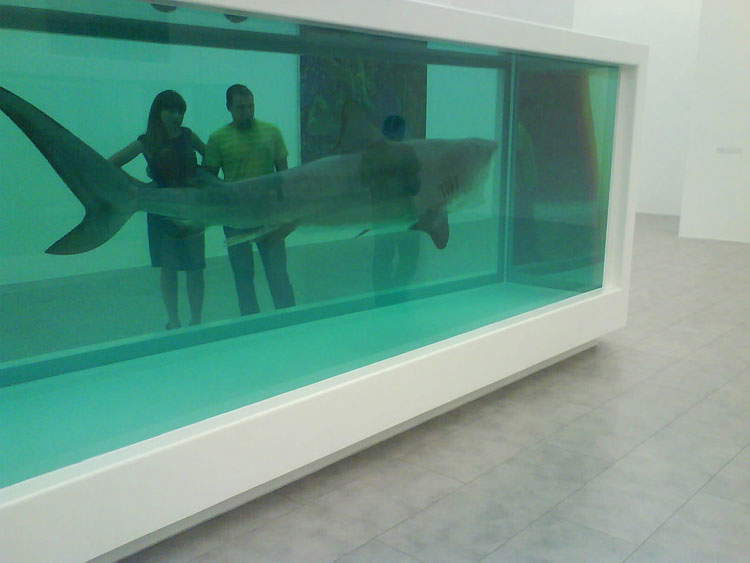How many animals have died from Damien Hirst's works? An estimate from Artnet
It was 1990 when Damien Hirst (Bristol, 1965) rose to world prominence with a work that remains indigestible to this day. The Young British Artists group, after the success of their first exhibition, Freeze, had organized other exhibitions, including a large show entitled Gambler (“Gambler”), at which Hirst presented, for the first time, his A thousand years (" A Thousand Years"), a work that purported to stage, before the eyes of visitors, the entire cycle of life. A large glass case housed the head of a decaying cow, on which some flies deposited eggs. From the eggs hatched larvae that fed on the cow’s fake blood (actually sugar and water), became flies in turn, and flew to the top of the vitrine, where Hirst had placed an insecticidal lamp that ended their existence. The following year, however, it was the turn of The physical impossibility of death in the mind of someone living: a great tiger shark, caught by an Australian fisherman on Hirst’s commission, submerged in a tank filled with formaldehyde.
Since then, Hirst has continued to use the corpses of animals, often specially killed, to make his works, arousing the ire of animal rights activists who continue to target the Englishman’s exhibitions even when no living beings are involved (this also happened a month ago in Venice, well before the subject of Hirst’s latest controversial exhibition was known: an animal rights association poured forty kilograms of manure in front of the entrance to Palazzo Grassi in protest against Hirst’s art). But how many animals have died over the years to bring Hirst’s works to life? Artnet magazine tried to make an estimate (“conservative,” they specify), published in an article signed by Caroline Goldstein.
 |
| Damien Hirst’s work Death Denied on display in Kiev in 2008. Photo credit |
The calculation is not the easiest, because for works such as the aforementioned A Thousand Years it is not possible to arrive at a precise number. However, Artnet tried to lavish the utmost accuracy, relying on Hirst’s exhibition and production catalogs and attempting to make, where the exact calculation of dead animals is a difficult task, estimates based on the duration of the exhibition, the surface area of the work, and the average size of the animal. The results were divided into four sections based on the different types of animals used, and a rough, but still realistic, total of dead animals for Hirst’s works was then calculated: Artnet speaks of 913,450 living things.
The first group is the farm animals displayed in formaldehyde cases: the simplest calculation, since it was enough to count the number of times the beasts appeared in Hirst’s production. This resulted in a total of 36 animals (13 sheep, 7 Friesian cows, 5 calves, 4 bulls, 3 foals, 2 pigs, plus a bear and a zebra, which Artnet included in this category). Of different proportions is the number of marine animals: the journal calculated a total of at least 685 (including 17 sharks and 668 fish of at least 38 species). More complicated, however, is the calculation of insects, such as flies used for works such as A Thousand Years and the Fly Sculptures, or butterflies used for the Kaleidoscope paintings. For the flies, Artnet made a rudimentary calculation, dividing the surface area of the paintings or sculptures by the average size of the animal and, in the case of some works (such as the Fly paintings) multiplying it by two, since on some works the animals were arranged in multiple layers (an estimated total of 850,000 flies, plus 111 generations of other flies used during the various exhibitions of A thousand years). The estimate for the Kaleidoscope paintings was more precise: the butterflies were painstakingly counted (Artnet gives the example of a single series of 62 canvases on which 1,629 butterflies were used). To these must be added another 9,000 or so butterflies that died for the installation In and out of love shown in a 2012 exhibition at London’s Tate Modern). Then we calculate another 45,000 insects of more than 3,000 species to which we also add 5 birds. The last category is that of remains, which are also used by Hirst on a par with whole animals: 46 sausages, a human skull, 624 organs from 8 cows, 16 cow skulls, 41 fish bones, and a mammoth skeleton were counted, for a total of 729 remains.
It must be said that Artnet’s calculation does not divide animals deliberately hunted or killed to enable the work to be done from those found already dead: a distinction along these lines would have been interesting as well. But it is nonetheless material for discussion again around the production of an extremely controversial character.
Warning: the translation into English of the original Italian article was created using automatic tools. We undertake to review all articles, but we do not guarantee the total absence of inaccuracies in the translation due to the program. You can find the original by clicking on the ITA button. If you find any mistake,please contact us.





























